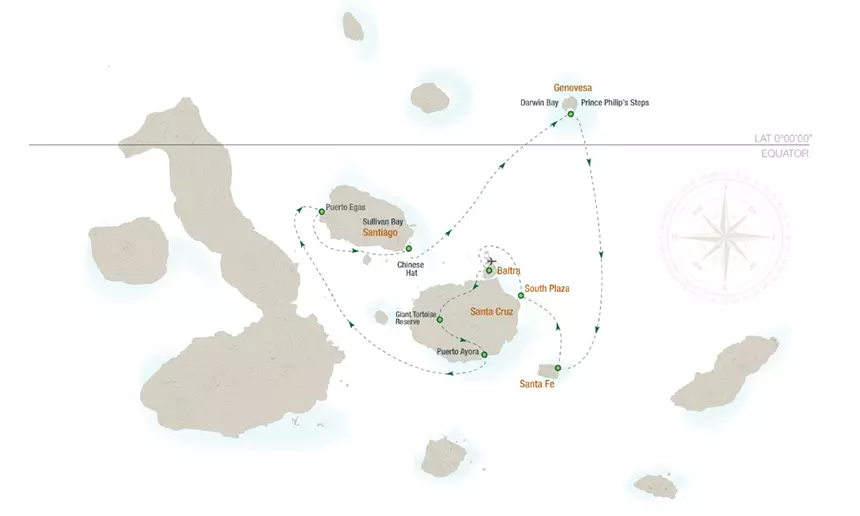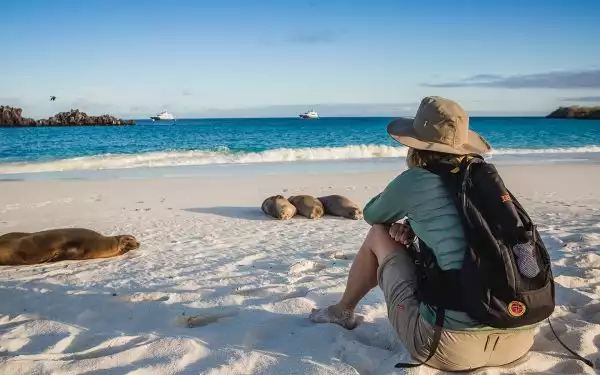What is the best Galapagos Islands itinerary? Which Galapagos Islands should you visit? How many days should you spend? With 13 major islands in the archipelago, each offering a unique mix of wildlife, it can be dizzying to figure out the best Galapagos cruise itinerary.
That’s where we come in. Below we share some tips to help you understand all the considerations that help us find your best match.
TIPS FOR FINDING THE BEST GALAPAGOS ITINERARY:
How Long & Why Length Matters
Wildlife Considerations
Island Groupings: East vs. West, South, North & Central
Traveler Favorites
View Itineraries by Interest
How Long to Go? Why Length Matters
We’ll let you in on a secret: For 90 percent of travelers, we actually advise not getting too hung up on a particular itinerary but to instead focus on your cruise length and choosing your Galapagos ship. If you book at least a 6 or 8-day cruise, you are sure to see a great, wide variety of Galapagos habitats and species.
As one of our longtime Adventure Specialists likes to say, “When it comes to which islands are better, please know there are no superior or inferior Galapagos itineraries/regions. The only way to minimize the quality of your experience is to go for a shorter time. The best way to maximize your experience is to go for a longer time.”
And if you stay two weeks, you don’t have to really focus on the itinerary at all. Why? The Galapagos National Park dictates sailing schedules and landing sites over a 15-day circuit to protect this treasured, pristine archipelago. Thus, among your choice of itineraries you will find more or less the same sites visited, just in different patterns.
Cruises shorter than 6 or 8 days will inevitably miss out on some species.
For the most comprehensive Galapagos cruise, choose a two-week, 15-day itinerary (all have no repeated landing sites), but there are a range of longer options between 8 and 15 days that are often sufficient for most travelers.
If you choose any cruise fewer than 6 days, carefully consider what islands and experiences are important to you. Shorter cruises will inevitably miss out on some species.
VIEW ALL CRUISES
See the full list of Galapagos itinerary options & filter by trip length.
Honing in Your Route for Wildlife
If a particular native animal is your focus, consider what stage of life and which species you’d like to witness the most. Your own best Galapagos cruise itinerary may depend on what breeding, hatching or other animal activity interests you the most. While no species are guaranteed to be seen, one of our Adventure Specialists can guide you through which islands are right for your interests. Our Galapagos Islands animals and Galapagos by Month: When to Go & Why blog are also great guides, outlining which animals are doing what when.

IN THE KNOW ON WHERE TO GO
Ask our experts who’ve been.
Island Groupings Explained: East vs. West
We are often asked, “Which Galapagos loop is best?” That is impossible to answer since cruise lines don’t follow the exact same paths. For example, some so-called “Western Islands” routes include stops in more southern islands like Espanola or Floreana, and others do not.
And itineraries are subject to change year over year, pending permitting from the Galapagos National Park. Ask us which one might suit your interests since our Galapagos specialists are up to date on the latest routes and their nuances.
That said, Galapagos Island cruise routes are often generally referred to by general directions: northern, southern, eastern and western islands, and combinations thereof. Below is a very general guide to these groupings:
Eastern Galapagos Islands Itinerary
The Eastern Galapagos Islands (example route map pictured below) are the oldest in the archipelago and are known for their white, sandy beaches. Eastern Galapagos itineraries often visit Lobos Island, San Cristobal Island and Espanola Island.
San Cristobal is the easternmost island of the Galapagos and is also home to one of the two airports in the archipelago. Many cruises embark or disembark here. Espanola is most notable to include for travelers seeking to spot the waved albatross. It can only be found on Espanola Island April through December.

Western Galapagos Islands Itinerary
Western Galapagos Island itineraries typically sail around the largest Isabela Island, and include stops at Santiago and Fernandina Islands. The western exposure means opportunities for spotting Galapagos penguins and exploring the youngest and most volcanically active islands in the archipelago.
Terrain here is more volcanic with cliffs on some parts of Isabela Island. Many visitor sites are by Zodiac only vs. landing on shore. And shore landings can have trickier footing due to lava terrain. But this remoteness is appealing due to less day-boat traffic and more wilderness areas.

Southern Galapagos Islands Itinerary
Southern Galapagos itineraries often visit the southernmost islands of Espanola and Floreana. These are among the oldest islands and thus have the sandiest beaches and a lot of human history, including the whaling traditions of Post Office Bay. As noted above, Espanola is a draw for those seeking waved albatross spottings.
Central Galapagos Islands Itinerary
Santa Cruz Island is a hub for most Galapagos cruise itineraries, no matter their other island groupings. And many itineraries utilize the airport out of nearby Baltra Island. So no matter which loop you choose, you’ll likely end up visiting a few central islands. Central Galapagos itineraries often visit Santiago, Baltra, Santa Fe, Bartolome Islands, Santa Cruz, South Plaza and/or Rabida Island.
Here you’ll find the most populated towns with infrastructure to support hotel-based travel, so landing sites here can feel less remote due to day-boat traffic. But note that the actual numbers of travelers at landing sites are regulated.

Northern Galapagos Islands Itinerary
Northern Galapagos itineraries features the longest at-sea crossing, to include a special visit to the bird-lover’s Genovesa Island. Galapagos scuba diving itineraries also visit these northern reaches of the Galapagos. In fact, the isolated islands of Darwin and Wolf are only visited by diving cruises.
VIEW ALL CRUISES
See the full list of Galapagos itineraries.

PICTURE YOURSELF HERE
Stay in the loop on Galapagos
& save when you go.


Comments will be moderated and will appear after they have been approved.